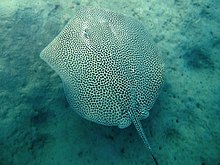Reticulate whipray
| Reticulate whipray | |
|---|---|
 |
|
| Scientific classification | |
| Kingdom: | Animalia |
| Phylum: | Chordata |
| Class: | Chondrichthyes |
| Subclass: | Elasmobranchii |
| Order: | Myliobatiformes |
| Family: | Dasyatidae |
| Genus: | Himantura |
| Species: | H. uarnak |
| Binomial name | |
|
Himantura uarnak (Forsskål, 1775) or (J. F. Gmelin, 1789) |
|
 |
|
| Range of the reticulate whipray | |
| Synonyms | |
|
Raia scherit Bonnaterre, 1788 |
|
Raia scherit Bonnaterre, 1788
Raja uarnak Gmelin, 1789
Raja sephen var. uarnak Forsskål, 1775
Raja uarnata Walbaum, 1792
Trygon maculata Kuhl & van Hasselt in Bleeker, 1852
Trygon punctata Günther, 1870
The reticulate whipray or honeycomb stingray (Himantura uarnak) is a species of stingray in the family Dasyatidae. It inhabits coastal and brackish waters across the Indo-Pacific region from South Africa to Taiwan to Australia, favoring sandy habitats. A large species reaching 2 m (6.6 ft) in width, the reticulate whipray has a diamond-shaped pectoral fin disc and an extremely long tail without fin folds. Both its common and scientific names refer to its ornate dorsal color pattern of many small, close-set dark spots or reticulations on a lighter background. However, the reticulate whipray is only one of several large spotted stingrays in the Indo-Pacific which, coupled with the variability of its coloration with age and locality, has resulted in a great deal of taxonomic confusion.
Often encountered resting on the bottom during daytime, the reticulate whipray is a predator of bottom-dwelling invertebrates and bony fishes. Like other stingrays, it is aplacental viviparous, with the developing embryos nourished at first by yolk and later by histotroph ("uterine milk"). Females bear litters of up to five pups in summer, following a gestation period of a year. The reticulate whipray is fished in Southeast Asia and parts of the Indian Ocean for meat, skin, cartilage, and other purposes. It is highly susceptible to population depletion because of its large size, inshore habits, and low reproductive rate, and is additionally threatened by extensive habitat degradation. Consequently, the International Union for Conservation of Nature (IUCN) has assessed this species as Vulnerable.
...
Wikipedia

